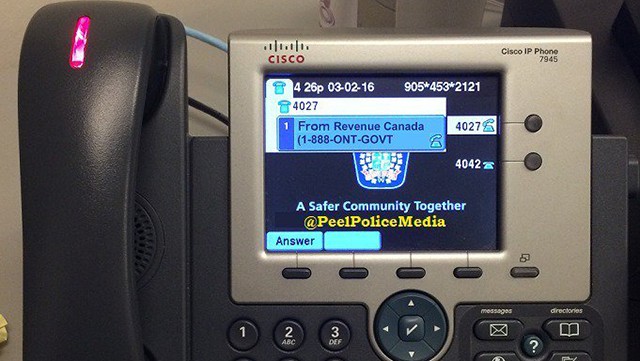Police Warning Mississauga Residents to Beware of Elaborate Scam
Published May 15, 2017 at 5:52 pm

Although scams are common all year round, some residents are especially vulnerable around tax time (especially if they have yet to pay outstanding taxes or just paid through potentially unfamiliar means, such as online through their financial institution).
For that reason, it’s good to be extra mindful of something known as caller ID spoofing–something Peel police recently warned residents to be wary of.
So, what is caller ID spoofing?
You can read a very succinct breakdown from the Canadian Radio-television and Telecommunications Commission (CRTC) here, but we’ll break it down for you.
As you likely know, your caller ID display typically shows you the name and number associated with the person or organization calling you. Caller ID spoofing occurs when someone’s name or business is altered to show something else.
While the CRTC points out that there may be legitimate reasons for an organization to alter caller ID information when making a call (a doctor, for example, might call from a personal line but display a general number for the hospital), it says that some people alter caller ID for less noble purposes.
“Unfortunately, illegitimate telemarketers may change the information that appears on the Caller ID display (a practice known as Caller ID spoofing) to misrepresent themselves and to trick Canadians into answering the call,” the CRTC writes.
What are some examples of spoofing? The CRTC offers the following examples:
-
The Caller ID may be altered to match the first 6-digits of your telephone number so that it looks like a local call, perhaps from a neighbour in your area, also known as ‘neighbouring.’
-
The Caller ID may display your own telephone number, also known as ‘mirroring.’
-
The Caller ID may display the number of another individual and/or organization (i.e., pose as a recognizable brand).
-
The Caller ID may be altered to represent a number that cannot be dialed within the telephone network (e.g. 123-456-7890, 999-999-9999, etc.)
So, if you get a call from a strange number with a display that indicates it’s from, say, the Canada Revenue Agency, but the caller asks odd questions or demands you pay a sum you did not owe via money order, hang up and report the call to the legitimate organization and/or local authorities.
According to the CRTC, telemarketers are required to accurately identify themselves. If they misrepresent who they are and what they do, they are acting in violation of the Unsolicited Telemarketing Rules and can face fines of $1,500 (for an individual) to $15,000 (for a corporation).
If you want to protect yourself from illegitimate organizations, you can reduce your chances of being targeted by registering your number on the National Do Not Call List, filing complaints about nuisance/scam calls to the police or Canadian Anti-Fraud Centre (1-888-495-8501), exercising caution if asked for personal information (when in doubt, hang up and call the institution yourself to confirm the issue), talking to your cell phone or landline provider about blocking nuisance numbers and keeping an eye on the CRTC’s Telemarketing Consumer Alerts.
Although the calls are worrying/annoying, the government is looking to curb them.
The CRTC says a decision was issued to “set out findings on technical solutions that Canadians could use to protect themselves from unwanted, unsolicited and illegitimate calls. The CRTC is also directing service providers to develop solutions to block nuisance calls within their network. Service providers must also report back to the CRTC, within 180 days, from the date of this decision, with details of the filtering services they offer, or intend to offer, to their subscribers.”
In short, if a call makes you suspicious and you believe the person on the other line is lying about who they are and what they’re doing, hang up and follow up with the organization they claim to represent. If it’s a scam, tell the appropriate authorities.
INsauga's Editorial Standards and Policies